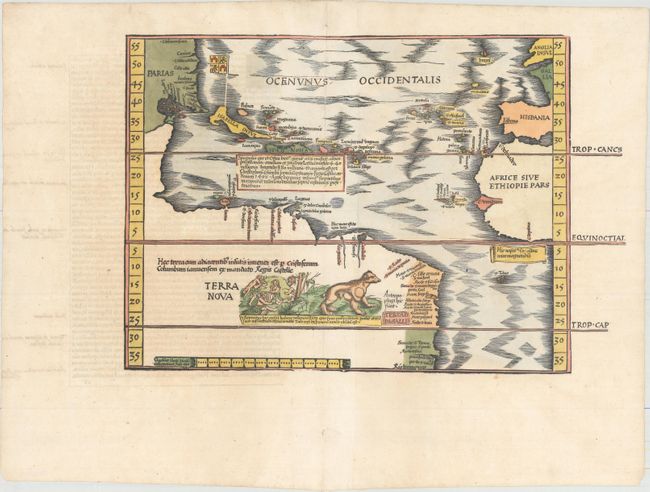Subject: Western Hemisphere - America, Atlantic Ocean
Period: 1541 (published)
Publication: Claudii Ptolemaei Alexandrini Geographicae...
Color: Hand Color
Size:
16.6 x 11.3 inches
42.2 x 28.7 cm
This is Laurent Fries' slightly reduced, and more decorative, version of Waldseemuller's landmark map covering the Atlantic coastline of the Americas. It is one of the earliest maps available to collectors of American maps. Waldseemuller's map was the first map devoted to the Americas to appear in an atlas. His map is often referred to as the Admiral Map because Waldseemuller attributed his source of information on the New World to 'the Admiral' - referring to Columbus. This was a change, however from his 12-sheet world map of 1507, on which Waldseemuller named the new continent America after Amerigo Vespucci. He soon realized his error and corrected it on his map of the Americas, first published in 1513, in which the new world was named simply Terra Incognita. Waldseemuller attempted further to distance himself from the false credit he had given to Vespucci by specifically crediting Columbus with two lines of Latin text, which read, "Hec terra cum adiacentib insulis inuenta est per Columbu ianuensem ex mandato Regis Castelle" (this land with its adjacent islands was discovered by Columbus, sent by authority of the King of Castile). Waldseemuller also used Portuguese manuscript maps as sources, including the portolan charts by Cantino (1502) and Caveri (circa 1505), particularly for the coastal place names shown in North America.
The geography of Fries' map follows that of the 1513 Waldseemuller and delineates the Atlantic from latitudes 35° south to 55° north, with a surprisingly accurate depiction of the American coastline. Fries added the Spanish flag flying over Cuba (named Isabella after the Queen of Spain) and a text block beneath Hispaniola describes the island and Christopher Columbus' discoveries in 1492. He also added graphic depictions of cannibals and a fierce-looking opossum, both of which had been reported by Amerigo Vespucci. He renamed the new world Terra Nova and retained the two famous lines of Latin text from the 1513 edition.
References: Burden #4; Goss (NA) #3; Portinaro & Knirsch, pp. 64-65; Mickwitz & Miekkavaara #211-28.
Condition: A
Excellent impression on paper with a bunch of grapes watermark and minor show through of text on verso. There is an old crease that has been pressed flat, with professional repairs to several short separations along the crease and the centerfold.


